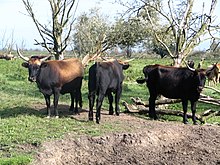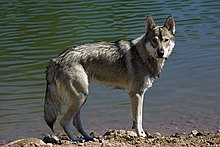What Kind Of Animal Does Maxi Want To Breed When He Returns Home, After The War?

Heck cattle were bred in the 1920s to resemble the aurochs.
Convenance back is a form of bogus selection by the deliberate selective convenance of domestic (but not exclusively) animals, in an attempt to achieve an animate being breed with a phenotype that resembles a wild type ancestor, usually one that has gone extinct. Breeding back is not to be confused with dedomestication.
Information technology must be kept in mind that a breeding-back breed may be very similar to the extinct wild type in phenotype, ecological niche, and to some extent genetics, but the genetic pool of that wild type was different prior to its extinction. Fifty-fifty the superficial actuality of a bred-back fauna depends on the item stock used to breed the new lineage. As a result of this, some breeds, like Heck cattle, are at best a vague look-alike of the extinct wild type aurochs, co-ordinate to the literature.[1]
Background [edit]
VOA written report about the Quagga Project
The aim of convenance dorsum programs is to restore the wild traits which may take been unintentionally preserved in the lineages of domesticated animals. Commonly, not only the new animal's phenotype, merely also its ecological capacity, are considered in back-breeding projects, as hardy, "bred dorsum" animals may be used in certain conservation projects. In nature, ordinarily only individuals well suited to their natural circumstances volition survive and reproduce, whereas humans select animals with additional attractive, docile or productive characteristics, protecting them from the dangers one time found in their bequeathed surroundings (predation, drought, illness, extremes of weather, lack of mating opportunities, etc.). In such cases, selection criteria in nature differ from those found in domesticated conditions. Because of this, domesticated animals often differ significantly in phenotype, behaviour and genetics from their wild forerunners. Information technology is the promise of breeding-back programs to re-express, inside a new breeding lineage, the wild, aboriginal traits that may accept "lain buried" in the DNA of domestic animals.
In many cases, the extinct wild type ancestors of a given species are known only through skeletons and, in some cases, historical descriptions, making their phenotype poorly understood. Given that state of affairs, in that location is currently no certainty of achieving success with a back-breeding attempt, and whatsoever results must be reviewed with great caution. In social club to test genetic closeness, Dna (both mitochondrial and nuclear) of the breeding animals must be compared against that of the extinct animal.
Successful breeding back might be possible: humans take selected animals only for superficial traits, and as a rule did not intentionally modify less-observable traits, such equally metabolic biochemistry.[1] Further, since many domestic species show behaviours derived from their wild ancestors (such as the herding instinct of cattle or the social instincts of dogs), and are fit to survive outside the sphere of human interference (as evidenced by the many feral populations of various domestic animals), information technology can be presumed that "bred back" animals might be able to function like their wild ancestors.[1] For case, food preferences are assumed to be largely the same in domesticated animals equally in their wild type ancestors.
Natural selection might serve every bit an additional tool in creating "accurate" robustness, "authentic" behaviour, and perhaps, the original phenotype as well. In some cases, a sufficient predator population would be necessary to enable such a selection procedure; in today'south Europe, where many breeding-back attempts take place, this predator population is largely absent.
Apply [edit]
Bred-back breeds are desirable in conservation biology, as they may fill an ecological gap left open by the extinction of a wild type due to human being activities. As long as food preference, behaviour, robustness, defense force against predators, hunting or foraging instincts and phenotype are the same as in the wild type, the bred-back phenotype will function similarly in the ecosystem. Releasing such animals into the wild would re-fill the previously empty niche, and allow a natural dynamic among the various species of the ecosystem to re-establish. However, not all breeding-back attempts will result in an animate being that is closer to the wild type than are primitive domestic breeds. For instance, Heck cattle bear less resemblance to the aurochs than exercise many Iberian fighting cattle.[i]
Examples [edit]
Aurochs [edit]

Ideas for creating an aurochs-similar animal from domestic cattle have been around since 1835. In the 1920s, Heinz and Lutz Heck tried to breed an aurochs expect-akin, using central European dairy breeds and southern European cattle. The result, Heck cattle, are hardy, but differ from the aurochs in many respects, although a resemblance in color and, less reliably, horns has been achieved.[1] From 1996 onwards, Heck cattle have been crossed with "primitive" Iberian breeds like Sayaguesa Cattle and fighting cattle, every bit well as the very large Italian brood Chianina, in a number of German reserves, in gild to enhance the resemblance to the aurochs. The results are called Taurus cattle, being larger and longer-legged than Heck cattle and having more aurochs-similar horns. Some other of the projects to achieve a type of cattle that resembles the aurochs is the TaurOs Project, using archaic, hardy southern European breeds, along with Scottish Highland cattle.
European wild horse [edit]

The Polish Konik horse is frequently erroneously considered the result of a breeding-dorsum experiment to "recreate" the phenotype of the Tarpan. The Konik is actually a hardy landrace brood originating in Poland, which was called Panje equus caballus before agriculturist Tadeusz Vetulani coined the proper name "Konik" in the 1920s. Vetulani started an experiment to reconstruct the Tarpan using Koniks; ultimately, his stock made only a pocket-size contribution to the nowadays-24-hour interval Konik population.[two]
During the Second World War, the Heck brothers crossed Koniks with Przewalski's horses and ponies, such equally the Icelandic horse and the Gotland pony; the consequence is now called the Heck Horse. During recent decades, Heck horses have been continually crossed with Koniks, making the two phenotypes at nowadays almost indistinguishable, excepting that the Heck horse tends to have a lighter build.[3]
As well the Konik-type horses, the Exmoor Pony, which notwithstanding lives in a semi-feral state in some parts of Southern England, has also been claimed to be closer to the European wild horse, equally information technology carries the primitive pangaré coloration and bears some resemblance to the horses seen in the Lascaux cavern paintings.[iv]
Pigs [edit]
Boar–grunter hybrids, which are hybrids of wild boars and domestic pigs and exist as an invasive species throughout Eurasia, the Americas, Australia, and in other places where European settlers imported wild boars to utilise as game animals, are also used for selective breeding to re-create the type of pigs represented in prehistoric artworks dating from the Iron Historic period and earlier in ancient Europe. A project to create them, nether the name of the Fe Age pig, started in the early 1980s by crossing a male wild boar with a Tamworth sow to produce an fauna resembling what Fe Age pigs are believed to have looked like.[5] Atomic number 26 Age pigs are more often than not only raised in Europe for the specialty meat market, and in keeping with their heritage are generally more aggressive and harder to handle than purebred domesticated pigs.[v]
Quagga [edit]
The Quagga Projection is an attempt, based in South Africa, to breed animals which strongly resemble the now-extinct quagga, a subspecies of the plains zebra which died out in 1883. Appropriately, the project is express to selecting for the physical appearance of the original, as recorded by xx-3 mounted specimens, many contemporary illustrations, and a number of written accounts of the animals.[6]
The two virtually noticeable characteristics of the quagga, fewer stripes and a darker pelage, are frequently observed to varying degrees in wild plains zebra populations. Animals with these ii traits have been sought out for the Quagga Projection breeding programme.[6] In its fourth breeding iteration, the Quagga Project has resulted in foals displaying faint to absent-minded striping on the hind legs and body, although the brownish groundwork color of the extinct quagga has nonetheless to sally. The project refers to their animals every bit "Rau quaggas", after the project founder Reinhold Rau.[seven]
The project has been criticized for its focus on the morphological characteristics of the quagga, as the extinct animal may have possessed unrecorded behavioral or non-visible traits that would be incommunicable to reliably breed back from plains zebras.[half-dozen]
Wolf [edit]

Although the wolf, the wild antecedent of domestic dogs, is not extinct, its phenotype is the target of several developmental breeds including the Northern Inuit Domestic dog and the Tamaskan Dog. They are all crossbreeds of High german Shepherds, Alaskan Malamutes and huskies, selected for phenotypic wolf characteristics. These new breeds may be viewed as breeding-back attempts as well.[8]
Although extinct, Japanese wolf Deoxyribonucleic acid survives in the mod domestic Shikoku Inu. It is thought that crossing this breed with some subspecies of Asian wolves would upshot in an authentic analogue to fill the ecological niche left empty in the absence of this noon predator.[ citation needed ]
The Dire Wolf Projection, started in 1988, aims to bring dorsum the look of the extinct prehistoric dire wolf by breeding unlike dog breeds that resemble it.[9]
Encounter too [edit]
- De-extinction
- Otto Antonius
- Preservation breeding
References [edit]
- ^ a b c d e Cis van Vuure: Retracing the Aurochs – History, Morphology and Ecology of an extinct wild Ox. 2005. ISBN 954-642-235-5
- ^ Tadeusz Jezierski, Zbigniew Jaworski: Das Polnische Konik. Die Neue Brehm-Bücherei Bd. 658, Westarp Wissenschaften, Hohenwarsleben 2008, ISBN 3-89432-913-0
- ^ Bunzel-Drüke, Finck, Kämmer, Luick, Reisinger, Riecken, Riedl, Scharf & Zimball: "Wilde Weiden: Praxisleitfaden für Ganzjahresbeweidung in Naturschutz und Landschaftsentwicklung
- ^ European Wildlife
- ^ a b McDonald-Brown, Linda (2009). Choosing and Keeping Pigs. Firefly Books. ISBN978-1-55407-469-3.
- ^ a b c The Quagga Project explained
- ^ The Quagga and Science.
- ^ Gamborg, C.; et al. (2010). "De-domestication: Ideals at the intersection of mural restoration and beast welfare" (PDF). Ecology Values. 19 (1): 57–78. doi:x.3197/096327110X485383.
- ^ "The Dire Wolf Projection". www.direwolfproject.com. Archived from the original on 6 May 2020. Retrieved 16 July 2019.
Further reading [edit]
- Koene, P., & Gremmen, B. (2001). Genetics of dedomestication in big herbivores. In 35th ISAE Conference, Davis, California, 2001 (pp. 68–68).
External links [edit]
- The Dire Wolf Projection
- The Quagga Project
- TaurOs Project
Source: https://en.wikipedia.org/wiki/Breeding_back
Posted by: collinsciat1966.blogspot.com

0 Response to "What Kind Of Animal Does Maxi Want To Breed When He Returns Home, After The War?"
Post a Comment